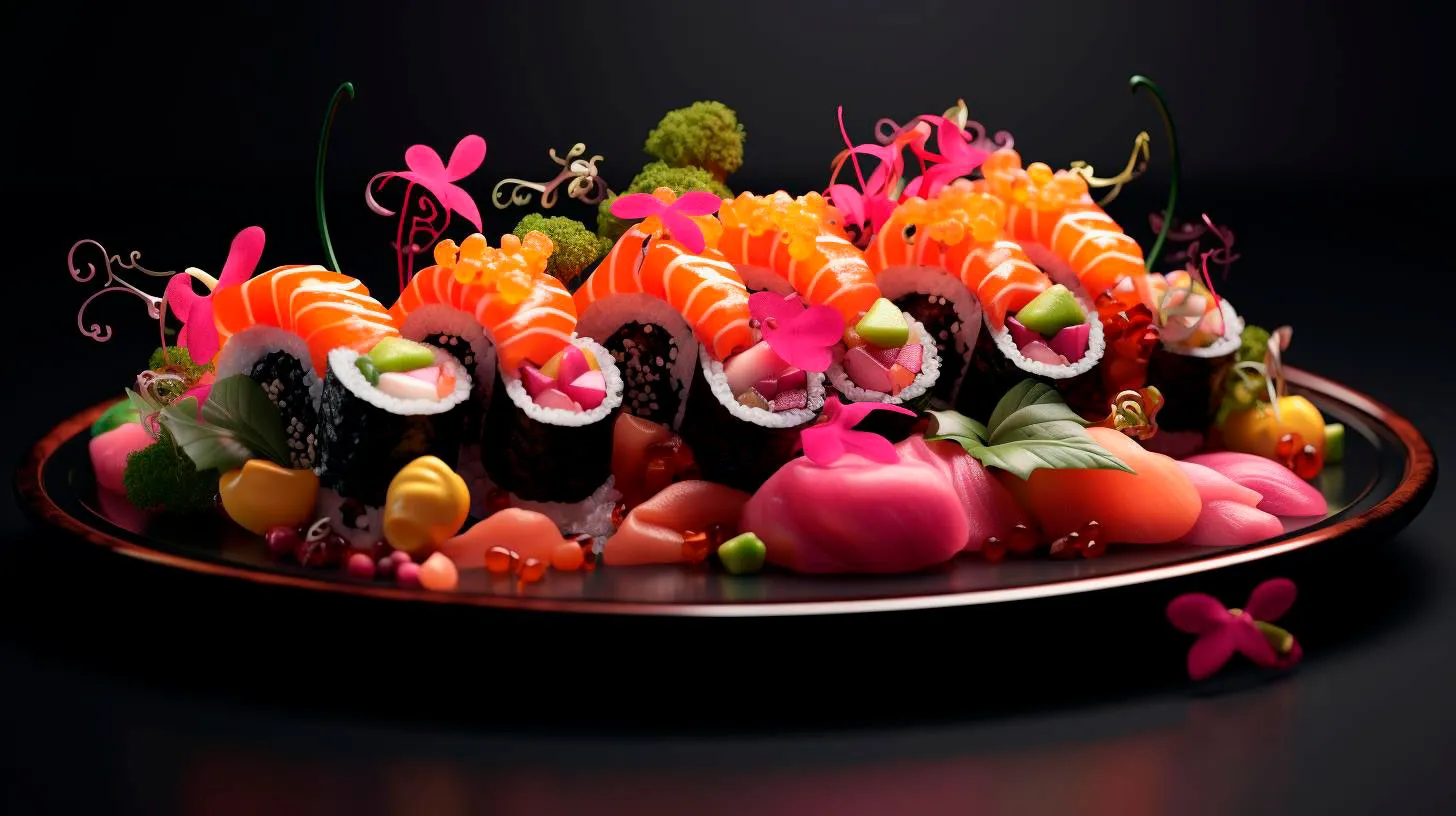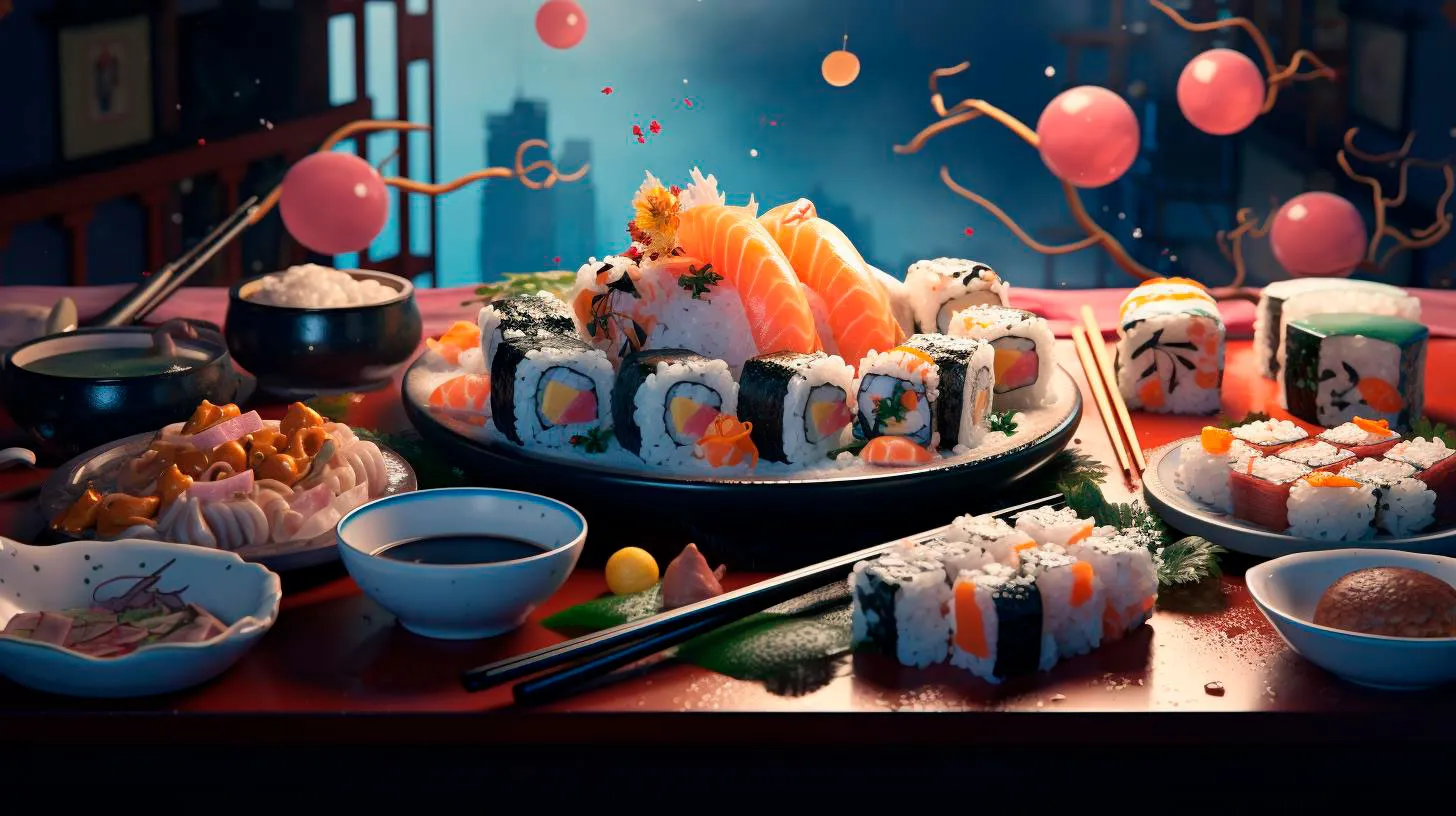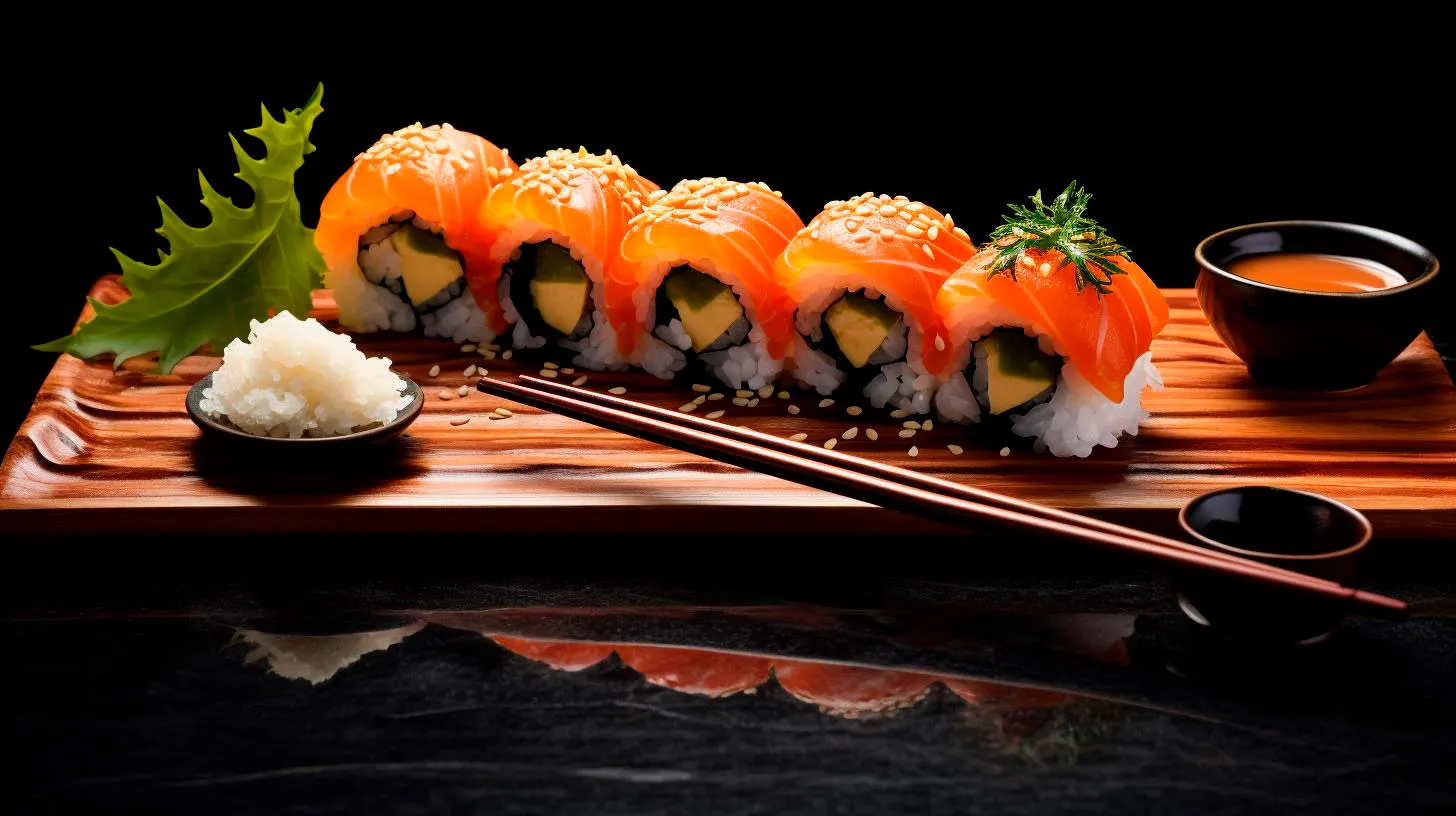Mastering the Fine Dining Experience: Savoring Sushi with Grace
But enjoying sushi isn’t just about satisfying your hunger; it’s also about immersing yourself in a unique cultural experience. To truly master the fine dining experience of savoring sushi with grace, there are a few key elements to keep in mind.
The Importance of Freshness and Quality
One of the defining characteristics of sushi is its emphasis on freshness and quality. The best sushi chefs meticulously source their ingredients, ensuring that only the finest and freshest seafood is used in their creations. When dining at a high-end sushi restaurant, you can expect the fish to be so fresh that it practically melts in your mouth. The attention to detail in selecting top-quality ingredients is what sets exceptional sushi apart from the rest.
- Key takeaway: Freshness is paramount in sushi. Opt for reputable restaurants with a focus on quality ingredients to enjoy the best dining experience.
The Art of Eating Sushi
While most people simply pick up their sushi with chopsticks and gobble it down, there is actually an art to eating sushi with grace. To fully appreciate each delicate piece, it’s important to take small bites, allowing the flavors to unfold on your palate. Take your time to savor the intricate balance of flavors and textures in each bite. And don’t be afraid to experiment with different dipping sauces, such as soy sauce and wasabi, to enhance the overall experience.
- Key takeaway: Savor each bite of sushi by taking small bites and allowing the flavors to mingle on your palate. Experiment with different dipping sauces for added enjoyment.
Understanding Sushi Etiquette
As with any fine dining experience, knowing and following proper etiquette is essential when enjoying sushi. Here are a few important points to keep in mind:
Sit at the counter:
If possible, choose a seat at the sushi counter to fully immerse yourself in the experience. Watching the skilled sushi chef at work adds a level of entertainment and authenticity to your meal.
Use your hands:
Contrary to popular belief, it is perfectly acceptable to eat nigiri sushi with your hands rather than chopsticks. This method allows you to fully appreciate the delicate texture of the sushi rice and the freshness of the fish.
Respect the chef:
When dining at a sushi bar, it’s customary to show respect to the chef through proper greetings and appreciation for their creations. A simple “Arigato gozaimasu” (thank you) goes a long way in establishing rapport and recognizing the chef’s craftsmanship.
- Key takeaway: Sit at the counter, use your hands to eat nigiri sushi, and show respect to the chef to fully embrace the sushi dining experience.
Health Benefits of Sushi
Beyond the exquisite flavors and artistry, sushi also offers numerous health benefits. Here are some of the advantages:
- High in omega-3 fatty acids: Fish used in sushi, such as salmon and tuna, are excellent sources of omega-3 fatty acids, which are known to promote heart health.
- Low in calories and fat: Sushi is generally low in calories and fat, making it a healthy option for those watching their weight or aiming for a balanced diet.
- Rich in vitamins and minerals: Sushi is packed with essential vitamins and minerals, including vitamins A, B6, B12, and minerals like iodine and selenium.
By choosing sushi as a regular part of your diet, you can enjoy both a delectable culinary experience and a boost to your overall well-being.
- Key takeaway: Enjoy sushi guilt-free, as it offers numerous health benefits due to its omega-3 fatty acids, low calorie and fat content, and rich vitamin and mineral composition.
Conclusion
Sushi is more than just a meal; it’s an art form that allows you to indulge your senses and experience a unique cultural tradition. By understanding the importance of freshness, savoring each bite, respecting sushi etiquette, and embracing the health benefits, you can truly master the fine dining experience of savoring sushi with grace. So, the next time you find yourself seated at a sushi bar, allow yourself to be transported to a world of elegance and culinary mastery.
Unveiling the Secrets Behind the Art of Sushi Making
Join us as we unravel the secrets behind the art of sushi making.
The History of Sushi
Before we dive into the intricacies of sushi making, let’s take a brief journey back in time. Sushi originated in Southeast Asia and was introduced to Japan around the 8th century. In its early stages, sushi was consumed primarily for its fermentation properties, allowing fish to be preserved for longer periods. Over the years, sushi evolved with the addition of vinegared rice, transforming it into the culinary masterpiece we know today.
The Basic Ingredients
A successful sushi dish revolves around fresh and high-quality ingredients. Understanding the key components will help you appreciate the flavors of this traditional Japanese cuisine.
- Fish: The most essential ingredient in sushi is undoubtedly the fish. Opt for fresh, sushi-grade fish such as tuna, salmon, or yellowtail.
- Rice: Sushi rice is a special variety of short-grain rice seasoned with vinegar, sugar, and salt. Its sticky texture is crucial to holding the sushi together.
- Nori: Nori is the black seaweed used to wrap the sushi rolls. It adds a subtle flavor and provides a natural wrapper for the ingredients.
- Vegetables and Fillings: Traditional sushi rolls often include fresh vegetables like cucumber, avocado, or pickled radish. You can also experiment with fillings like cooked shrimp, crab, or tempura.
- Sauces and Condiments: Soy sauce, wasabi, and pickled ginger are commonly served alongside sushi to enhance the flavors.
The Art of Sushi Making
Creating sushi is a meticulous process that requires skill and precision. Here are the steps involved in making sushi:
1. Preparing the Rice
The first step in sushi making is cooking the rice. Use a short-grained variety and follow the instructions carefully. Once cooked, the rice is seasoned with a mixture of vinegar, sugar, and salt. This step is crucial as it gives the rice its distinctive flavor and sticky texture.
2. Slicing the Fish
If you’re using raw fish, it needs to be sliced with precision. A sharp knife and a steady hand are key to achieving clean cuts. Slicing the fish at an angle ensures that each piece will fit perfectly on top of the rice.
3. Assembling the Sushi
Now comes the fun part – assembling the sushi rolls. Lay a sheet of nori on a bamboo sushi mat and spread a thin layer of rice evenly over the seaweed. Leave a small border at one end for sealing the roll. Arrange the fish, vegetables, or fillings in the center of the rice. Roll the sushi tightly using the mat, applying gentle pressure to secure the ingredients.
4. Cutting and Presenting
After rolling the sushi, it’s time to give it its final shape. Dip a sharp knife in water to prevent sticking, then carefully slice the sushi roll into bite-sized pieces. Present the sushi on a plate, garnish as desired, and serve with soy sauce, wasabi, and pickled ginger.
The Advantages of Making Sushi at Home
Now that you know the secrets behind the art of sushi making, let’s explore the perks of preparing sushi in the comfort of your own kitchen:
- Customization: Making sushi at home allows you to experiment with different fillings, combinations, and sauces, catering to your taste preferences.
- Freshness: By handpicking the ingredients, you have control over the quality and freshness of the fish and vegetables used.
- Healthiness: Sushi can be a nutritious meal choice, as it is often low in fat and packed with protein, vitamins, and minerals.
- Socializing: Preparing sushi at home can be a great activity to share with friends or family, allowing everyone to participate in the sushi-making process.
Key Takeaways
Sushi making is not just about the final result, but also about the journey and experience. By understanding the history, ingredients, and techniques involved, you can truly appreciate the art form behind this beloved Japanese cuisine. Whether you’re an aspiring sushi chef or simply a sushi enthusiast, now you have the knowledge to impress your friends and family with your sushi-making skills. So, put on your apron, grab your bamboo mat, and embark on a culinary adventure into the world of sushi making!
Sushi Etiquette: Navigating Customs and Traditions
Whether you’re a seasoned sushi lover or a beginner, understanding sushi etiquette is crucial to fully appreciate this culinary artform. In this article, we will navigate through the customs and traditions that surround sushi, giving you a deeper insight into the cultural significance of this beloved dish.
The Importance of Sushi Etiquette
Before delving into the specific customs, it’s essential to understand why sushi etiquette holds such significance. Japan, a country renowned for its meticulous attention to detail, has a rich cultural heritage associated with dining. By adhering to sushi etiquette, you not only show respect for the chef and the establishment but also immerse yourself in the Japanese way of life. Appreciating and embracing these customs will elevate your sushi dining experience to a new level.
Sushi Etiquette Dos and Don’ts
1. Using Chopsticks Correctly
Using chopsticks is an art in itself and is especially crucial when enjoying sushi. Here are a few pointers:
- Avoid rubbing the chopsticks together as it can be seen as an insult to the chef, implying that the chopsticks are cheap and need polishing.
- When not in use, place your chopsticks on the provided chopstick rest or a small plate but avoid sticking them vertically into a bowl of rice, as this resembles a funeral ritual.
2. Eating Sushi
The way you eat sushi also has its own set of customs:
- Eat the sushi in one bite if possible, as the chef designs it that way to provide a perfect harmony of flavors.
- Avoid dipping the rice-side of the sushi into soy sauce; instead, dip the fish-side lightly. This prevents the rice from absorbing too much soy sauce, compromising its delicate flavor.
3. Interacting with the Chef
A unique aspect of dining at a sushi bar is the opportunity to interact with the chef:
- It is customary to greet the chef upon entering the establishment.
- Engage in conversation as the chef prepares your sushi, expressing your appreciation for the artistry and flavors.
The Art of Omakase
Omakase, meaning “I’ll leave it up to you,” is a dining experience where the chef selects the sushi for you. This practice is highly regarded, allowing the chef to showcase their expertise. Here are a few things to keep in mind:
- Trust the chef’s choices and avoid turning down any sushi offered, unless you have dietary restrictions or allergies.
- Refrain from adding additional soy sauce or wasabi to the sushi, as the chef has already expertly flavored it according to their vision.
The Delicate Chawanmushi and Sake Ritual
Chawanmushi, a traditional Japanese savory egg custard, is often served as an appetizer in sushi establishments. Pairing it with sake creates a harmonious experience:
- Chawanmushi is typically served in a small porcelain cup, and it’s important to hold it gently to avoid spills.
- When toasting with sake, it is customary to hold the cup slightly lower than the person you are toasting with, showing respect.
- Never pour your own sake; instead, pour for others and wait for them to reciprocate.
Key Takeaways
Understanding sushi etiquette allows you to fully embrace the cultural significance associated with this culinary art. By following these customs, you show respect for the chef, the establishment, and the Japanese way of life. Here are the key takeaways:
- Pay attention to how you use chopsticks and avoid any disrespectful gestures.
- Eat sushi in one bite to experience the chef’s intended flavors.
- Engage with the chef and express your appreciation for their artistry.
- Experience the art of omakase and trust the chef’s choices.
- Be mindful of the delicate chawanmushi and sake rituals.
Sushi etiquette enhances the overall dining experience, allowing you to fully appreciate the craft of sushi-making. By immersing yourself in these customs and traditions, you not only savor the flavors but also show reverence for the rich cultural heritage Japan has to offer.
Exploring the Fascinating History of Sushi Culture
But have you ever wondered about the origins and the fascinating history behind this delectable cuisine? In this article, we will take a journey through time to explore the captivating history of sushi culture.
The Origins of Sushi
The origins of sushi can be traced back to Southeast Asia, where fish was preserved by fermenting it with rice. The process of fermenting rice with salted fish not only preserved the fish but also enhanced its taste. As this method traveled to Japan, it underwent several transformations, leading to the birth of sushi as we know it today.
Here are some key takeaways about the origins of sushi:
- Sushi originated in Southeast Asia and was brought to Japan.
- Originally, sushi was a preservation technique for fish.
- The fermentation process enhanced the flavor of the fish.
Edo Period – The Birth of Modern Sushi
During the Edo period (1603-1868) in Japan, sushi underwent significant changes and started to resemble its modern form. It was during this time that the concept of combining vinegared rice with fish became commonplace.
Sushi became a popular food option for the working class in Edo, now known as Tokyo. Street vendors known as “sushiyas” began offering quick and affordable sushi options to satisfy the growing demand. These early sushi stalls laid the foundation for the development of sushi as a casual and accessible food choice.
Key takeaways about the Edo period and the birth of modern sushi:
- Vinegared rice was combined with fish during the Edo period.
- Street vendors called “sushiyas” popularized sushi.
- Sushi became a convenient and affordable food option.
Sushi Evolution in the 20th Century
As Japan transitioned into the 20th century, sushi continued to evolve. Western influences began to shape the sushi culture, introducing new ingredients and techniques. In the 1960s, the invention of the refrigerated truck allowed sushi to be transported over long distances, enabling its popularity to spread beyond Japan’s borders.
During this time, sushi chefs started to experiment with different fish varieties, leading to the emergence of nigiri sushi, maki rolls, and sashimi. The focus shifted from preserving fish to showcasing its freshness and quality.
Key takeaways about the evolution of sushi in the 20th century:
- Western influences introduced new ingredients and techniques.
- Transportation advancements allowed sushi to be enjoyed globally.
- Nigiri sushi, maki rolls, and sashimi gained popularity.
Sushi Today – A Global Phenomenon
Today, sushi has become a beloved cuisine worldwide. Its popularity can be attributed to its health benefits, unique flavors, and elegant presentation. With sushi restaurants found in almost every major city, people from different cultures and backgrounds have embraced this culinary delight.
Sushi has also adapted to cater to various dietary preferences and restrictions. Vegetarian and vegan sushi options are now readily available, allowing everyone to indulge in this exquisite delicacy.
Key takeaways about sushi today:
- Sushi is loved globally for its health benefits and unique flavors.
- It has become a symbol of culinary sophistication.
- Vegetarian and vegan options cater to diverse dietary preferences.
Conclusion
Sushi has come a long way from its humble beginnings as a preservation technique. Its journey from traditional street food to an internationally recognized cuisine showcases how food culture evolves and adapts over time.
The fascinating history of sushi culture teaches us that culinary traditions can be shaped by a variety of factors, such as geography, technology, and societal shifts. So the next time you enjoy a piece of sushi, take a moment to appreciate the rich history behind this cultural icon.



